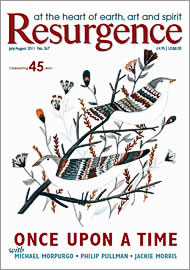This year marks the centenary of the birth of E.F. Schumacher, the economist and philosopher whose teachings inspired much of today’s green movement. Schumacher is best known for his groundbreaking classic book Small Is Beautiful. Never has a book title encapsulated so well a whole approach to life. And Schumacher’s views on sustainability and decentralisation have as much relevance today as they did when he first developed them almost 40 years ago – if not more so. Particularly where energy is concerned.
Recognising that sorting out energy was the key to cutting carbon, I set up Good Energy to be a catalyst for change in the energy industry. I wanted to empower individuals to choose a 100% renewable electricity supply, and to help them to connect with the innovative, independent pioneers who were generating energy from wind, water and sunlight. We now support a community of almost 2,000 independent green energy generators, supplying over 26,000 domestic and business customers throughout Britain with 100% renewable electricity. Since we started in 1999, we’ve saved 365,243 tonnes of carbon.
Good Energy has a vision for a decentralised and democratic energy network for the whole of Britain. Energy does not need to be complex and mysterious, delivered by large, remote corporations, and Schumacher knew this. In fact, our experience shows that ordinary people, businesses and communities throughout the UK, giving us greater independence and greater energy security, can make it.
When it comes to energy production, small really is beautiful, which is why we believe that government policy needs to do more to ensure that decentralised generation plays a key role in meeting our future energy needs. Producing and using energy locally where it is needed is far more efficient than moving it around the country. It also makes energy a visible part of the local community, reconnecting people with the source of their energy so they value it more highly.
The UK has a binding target to meet by 2050: we must reduce our carbon emissions by 80% from the 1990 baseline figure. And ‘business as usual’ is not going to get us there. We need to disrupt the existing system and find a different way of producing energy. If we can do so, we can not only meet these targets, but exceed them. The UK can become 100% renewable by 2050. We know this, because we’ve developed a pathway for reaching this ambitious goal – a pathway that involves changes to UK energy at every stage of the process, from grid management to investment, and from R&D to transport.
In Britain today, 97% of our energy comes from fossil fuels, and almost the same proportion is centralised and produced by a few very large operators. Some two-thirds is imported from abroad, and, if nothing else, recent events in both the Middle East and Japan have underlined the importance of moving away from reliance on finite fossil fuels and nuclear-generated energy to an unlimited supply of 100% renewable energy. This also means moving away from a few centralised suppliers to a distributed generation model, giving us greater energy stability, security and independence. Instead of energy being produced far away from where it’s needed, we need to start producing and using energy locally. That’s why, throughout this year, we are campaigning hard with our partner organisations to make sure that the government truly commits to the future of decentralised energy in the UK.
We also need to change how energy is used in the UK. For too long we have taken for granted that at the flick of a switch the lights come on and we don’t think about where it comes from. We need to re-educate people about where their energy comes from, because when people understand this they will value it more and use it less.
In the UK of 2050, even with a significant transformation in consumer behaviour and smarter technology in our homes and businesses, we are expecting electricity demand to double as transport and heating are electrified. But can we meet that new demand with renewables?
As the windiest country in Europe, and with over 11,000 miles of coastline, the UK has renewable resources in abundance, but we also have a lot of catching up to do compared with the rest of Europe. We currently generate only 2.2% of our power from renewables, a figure that compares to 44.4% in Sweden, 9% in Germany and 11% in France.
Switching to renewables starts with creating the right conditions for encouraging investment. We’re going to need about £200 billion, but currently the risks are too high and the rewards are too low. The government needs to take the lead and legislate to give investors the support they need. The Green Investment Bank is a start, but more work needs to be done.
Next, we need to look at how we manage demand with the variable supply that is inherent with renewables, so that we can match the times when the wind is blowing, the sun is shining and the rain is falling with the times our energy usage is the greatest. This will require investment in energy-storage solutions and a two-way European smart grid. One not-so-futuristic scenario is the use of electric cars not only to store energy for their own propulsion, but as batteries that can discharge energy for use when people are at home in the evenings, when their energy usage goes up. Another is automatic links between the grid and domestic appliances, so that fridges switch on and off automatically in tune with energy output. This is not the stuff of science fiction; the technology to do this already exists.
The last piece of the puzzle will be reforming the way energy is traded in the wholesale markets, and work is already under way on this with the government’s new electricity markets reform proposals. Not only do we need a sensible carbon price that will confer a genuine advantage to buying renewable energy, but we should also give precedence to renewable energy in the grid, so that fossil-fuel-generated power comes last, not first.
This may all sound like an idealistic vision, but there is an inspiring example of all this in action on the Isle of Eigg. The extreme weather on this small Hebridean island makes it an ideal place to harness the elements and generate renewable power, so members of the community decided on an ambitious project to develop their own grid, powered by renewables.
Previously, most buildings used oil and coal for heating, and diesel for generators – all brought across by ferry from the mainland. The new grid is supplied by three hydro generators, four wind turbines and solar PV panels. When these are generating a surplus, power is conserved in batteries or used to heat communal buildings, and there are backup diesel generators for times when the grid needs a boost.
Renewable generation meets up to 95% of the island’s energy requirement because people are careful with what they use. Each domestic property can use 5kW at any one time (enough for an electric kettle and a washing machine to run simultaneously), and everybody has an energy monitor so they can track their usage. A ‘traffic light’ system lets everyone know by email when renewable sources are low so that they can be extra prudent and only use energy if it’s absolutely vital. The islanders of Eigg have demonstrated how small really is beautiful. And there are encouraging signs that big businesses are waking up to this too.
Everybody has a role to play in our renewable energy future, from taking responsibility for the energy we buy and use to installing small-scale renewable technologies such as solar panels and small wind turbines. The energy landscape of the future will be transformed from one dominated by a few large, faceless corporations to an energy democracy that supports thousands of independent generators, making clean, green energy in their homes and communities across the country.
Something Schumacher would surely have been proud of.
This article is adapted from the Schumacher Lecture series.








